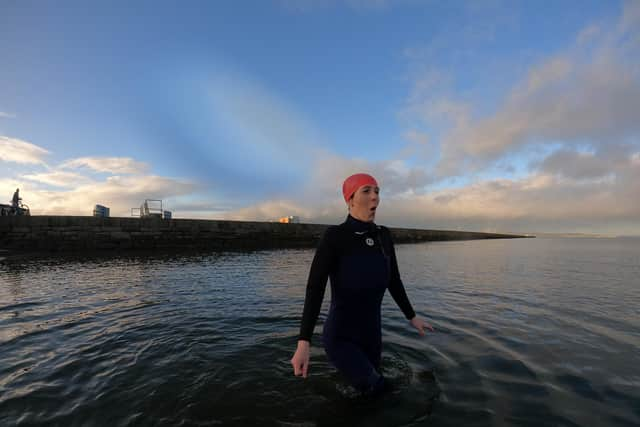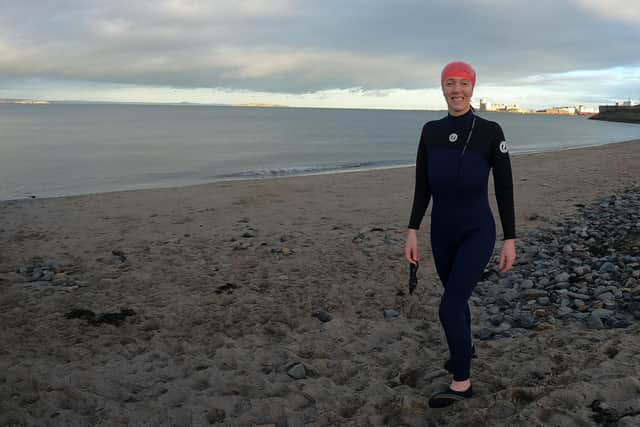Taking the plunge into winter wild swimming at Wardie Bay
My local beach at Wardie Bay has seen a huge surge in people taking to the Forth year-round. And I’ve heard from many intrepid dippers about the health benefits of the sport.
After a dip in my mental health during early lockdown with no gym or open baths to keep me on an even keel I decided to get outside and have a go.
Advertisement
Hide AdAdvertisement
Hide AdWhen at a real low ebb it seemed my social media was filled with pals baking sourdough, tending allotments and getting fit. I was just about getting through an impossible work and childcare juggle.


Inspired by hardy locals I had a few costume only dips or “skins” in summer and up to October. But it was just dabbling. I decided to properly take the plunge.
On the day of my first winter sea swimming lesson the cars were thick with frost. A yellow weather warning was issued across the Lothians’. It was a bitterly cold early December afternoon.
The water temperature was around nine degrees, warmer than outside the water. This should have been reassuring.
But as I stood on the beach shivering pulling on a brightly coloured cap I couldn’t help but think I had truly lost the plot.


Swim coach Colin Campbell put me at ease. He recently started offering weekly winter swimming lessons here after groups like Wardie Bay Wild Ones helped shore up popularity of the sport in recent months.
He also provided a chapter of safety advice in ‘Taking the plunge’ a book by local photographer Anna Deacon on the phenomenon of wild swimming.
I told myself I was in safe hands and tried to block out thoughts of how cold-water shock sends the body into a state where it thinks it’s dying.
Advertisement
Hide AdAdvertisement
Hide AdIt’s no surprise that lessons are in demand when the philosophy is ‘swim at your own risk’. There’s plenty to consider from the tides and weather conditions to the right kit and after-swim recovery. Colin kept me on track with a thorough safety briefing, pitched just right for a newbie.
After a recent wake-up call to the dangers of wild swimming I had serious concerns and plenty questions. I’d braved a Pentlands reservoir in just a swimsuit for over half an hour and came out feeling unstoppable, but very rapidly became faint and shaky with slurred speech. A friend saved me with a flask of hot coffee and a dry robe.
Colin explained what I had experienced was after-drop, the early stages of hypothermia. My body had shut down and my core temperature kept falling after I got out of the water.
He stressed this is the first golden rule of safety. When the rush of euphoria kicks in that’s the time to get out. It’s a bit like going into the water in the first place - it feels counter intuitive.
For the December dook I was set. I had after-swim kit, hot chocolate on standby and Colin to help guide me on how long I should stay in the water.
Still. It took a while to work up the bottle. The first few steps were tough.
Colin guided me to stride in confidently. Deep breaths. Just believe that the water isn’t really that cold. You’ve got this. Mind over matter.
NOT THAT COLD? Sharp pain pummelled my body.
After much shrieking and swearing Colin helped me get into a positive mindset. Guided breathing techniques helped keep panic at bay.
Advertisement
Hide AdAdvertisement
Hide AdThough I couldn’t help but think I’d be lucky if I kept all my fingers and toes!
Next it was time to get the face in. And splash water down my neck and back.
Surprisingly it helped. Almost as much as thoughts of curling up with Outlander and a cuppa.
I settled down and rolled onto my back. This was it. I had pushed through the pain and was buzzing. I managed to go out of my depth, swim underwater, attempt (and fail) at a forward roll and dive down to pick up sand.
And the unexpected challenges made it more of an adventure. The wetsuit helps stay in the water for longer but it also makes the body extra buoyant. Doing front crawl or breast stroke is definitely more fun when your bum keeps flying up into the air. Laughing took the edge off. And the buoyancy meant I had to work harder to push through the strokes.
I wanted to stay in bobbing about looking up at the pink-tinged dusky sky as tide came in. But I remembered the golden rule. Get out when the high kicks in. And when you can no longer feel your feet!
For the rest of that day I was full of energy. And I felt positive effects the next day too from eased back pain to a deep sleep.
As a beginner I’ve a lot to learn especially about keeping my dignity in the sea. But it’s safe to say I’ve caught the swimming bug. And I can’t wait to brave a New Year’s day loonies dook. I might keep the wetsuit on though….
Kit you’ll need for a winter wild water swim
· Swim suit
· Goggles
· Bright coloured swim hat
Advertisement
Hide AdAdvertisement
Hide Ad· Towel (needs to be big enough to change under), or a poncho/dry robe.
You should also bring:
· Flask of a warm drink (not hot/scalding)
· Warm jumper and an additional layer or three!
· Woolly hat
· Loose clothes that are easy to throw on after your swim
· If it's raining, a waterproof coat, waterproof bag for your stuff. Perhaps even an umbrella if not too windy
· An extra jumper or layer!
You might like to also bring:
· swimming gloves and/or boots (neoprene)
· something to stand on, such as a piece of mat
· mitts
Comments
Want to join the conversation? Please or to comment on this article.